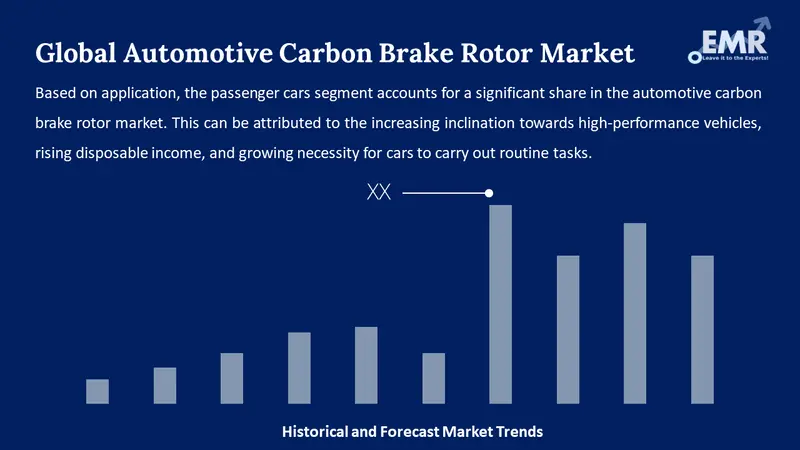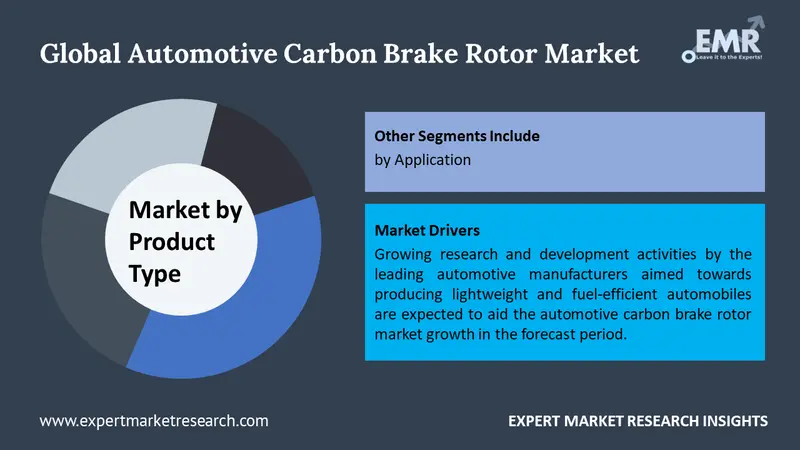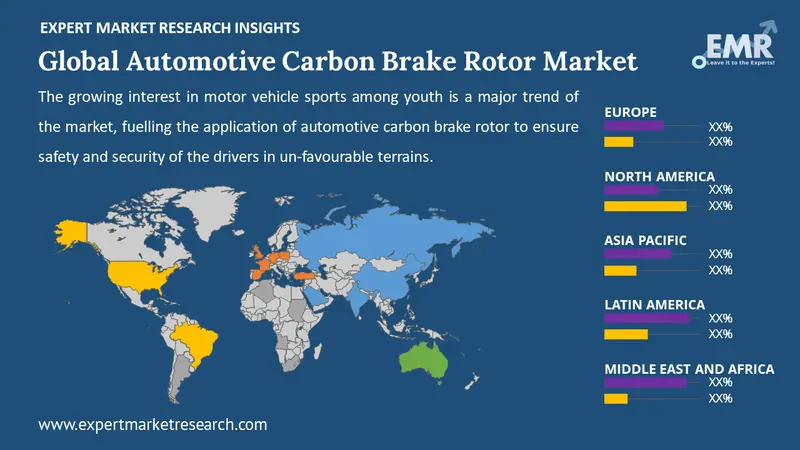Reports
Sale

Global Automotive Carbon Brake Rotor Market Share, Growth, Trends, Analysis, Forecast: By Product Type: Carbon-Carbon Matrix, Carbon-Ceramic Matrix; By Application: Passenger Cars, Light Commercial Vehicles (LCV), Heavy Commercial Vehicles (HCV), Motor Sports Vehicles, Others; Regional Analysis; Competitive Landscape; 2024-2032
Global Automotive Carbon Brake Rotor Market Outlook
The global automotive carbon brake rotor market size is expected to grow at a CAGR of 7.20% between 2024 and 2032. The market is being driven by the thriving transportation sector and heightened demand for automotive carbon brake rotors in cars, buses, and trucks.

Read more about this report - REQUEST FREE SAMPLE COPY IN PDF
Key Trends in the Market
Automotive brake rotors are components of the braking system of automotives that are fixed in a wheel and convert kinetic energy into thermal energy in order to de-accelerate the vehicle. Automotive carbon brake rotors are a type of rotors which can endure large amounts of heat that are generated upon braking vehicles; hence, they are used in high performance vehicles.
- The automotive carbon brake rotor market is being driven by the heightened demand for them in cars, buses, and trucks to improve the productivity of transportation and increase the comfort of the driver.
- The growing interest in motor vehicle sports among youth is a major trend of the market, fuelling the application of automotive carbon brake rotor to ensure safety and security of the drivers in un-favourable terrains.
- Growing research and development activities by the leading automotive manufacturers aimed towards producing lightweight and fuel-efficient automobiles are expected to aid the automotive carbon brake rotor market growth in the forecast period.
Opportunities and Challenges
The favourable policies of various governments aimed towards reducing the wastage of fuel and improving vehicular efficiency are likely to offer lucrative opportunities to the market for automotive carbon brake rotors as they reduce the vehicle weight. The rising demand for luxury cars, owing to the increasing standards of living across the developing nations, is further escalating the market revenue.
However, the high costs of automotive carbon brake rotors in comparison with the conventional braking systems is likely to pose a challenge in the automotive carbon brake rotor market in the forecast period.
Market Analysis

Read more about this report - REQUEST FREE SAMPLE COPY IN PDF
Based on product type, the market is segmented into carbon-carbon matrix and carbon-ceramic matrix. On the basis of application, the market is classified into passenger cars, light commercial vehicles (LCV), heavy commercial vehicles (HCV), and motor sports vehicles, among others. The regional markets for automotive carbon brake rotors are divided into North America, Europe, the Asia Pacific, Latin America, and the Middle East and Africa.
The comprehensive EMR report provides an in-depth assessment of the market based on the Porter's five forces model along with giving a SWOT analysis. The report gives a detailed analysis of the following key players in the global automotive carbon brake rotor market, covering their competitive landscape and latest developments like mergers, acquisitions, investments and expansion plans.
- SGL Group
- Wilwood Engineering, Inc.
- Brembo SpA
- Akebono Brake Industry Co., Ltd.
- Surface Transforms Plc
- Others
Market Share by Product Type
The carbon-ceramic segment, based on product type, accounts for a healthy share of the automotive carbon brake rotor market as carbon-ceramic brake rotors are witnessing a heightened demand from sports cars which is a key driving factor of this segment. Carbon-ceramics offer great advantages which bolster the overall performance of a vehicle. These include lower costs, high performance breaking under different conditions, lightweight, enhanced comfort and safety, high hardness, reduced rate of wear, and high resistance to deformation. Carbon-carbon, on the other hand, provides the strength and benefits of aluminium while reducing the weight of the vehicle. In this regard, the carbon-carbon segment is expected to witness steady growth in the forecast period.
Market Share by Application
Based on application, the passenger cars segment accounts for a significant share in the automotive carbon brake rotor market. This can be attributed to the increasing inclination towards high-performance vehicles, rising disposable income, and growing necessity for cars to carry out routine tasks. Increasing car brand awareness among the millennials is further propelling the demand for passenger automobiles. Moreover, the rising investments towards the development of premium passenger car models with innovative crossover seats and greater comfort levels, are further providing impetus to this segment.
Market Share by Region
At a regional level, North America accounts for a significant share in the automotive carbon brake rotor market due to the increasing demand for luxury passenger vehicles across well-established economies such as the United States. Growing mergers and collaborations of major automotive companies with aerospace firms like NASA, to solve automobile problems such as brake fade, lack of vehicle range, and lower fuel efficiency, is augmenting the market dynamics in this region. Meanwhile, Europe is expected to offer lucrative opportunities to the market owing to the strong automotive infrastructure across Germany and Italy.

Read more about this report - REQUEST FREE SAMPLE COPY IN PDF
Competitive Landscape
SGL Group is a long-standing carbon and graphite manufacturing company which caters to the diverse demands of the automotive sector. The company’s products, materials, and engineered downstream carbon and graphite products utilise their advanced expertise in automotive engineering. The company was founded in the year 1992 and is currently headquartered in Wiesbaden, Germany.
Wilwood Engineering, Inc. is a prominent manufacturer and marketer of high-performance disk brake systems which was established in 1977 and is currently headquartered in California, United States. The company also manufactures brake systems with a combination of off-shelf and custom components. Wilwood Engineering, Inc. also produces snowmobiles, quads, and utility vehicles, among other automobiles.
Brembo SpA is a leading automobile company which manufactures brake systems, high-performance cars and motorcycles, and innovates in automotive disk brake technologies. The company was founded in the year 1961 and is currently headquartered in Curno, Italy. Brembo SpA also manufactures race car components along with original equipment and upgrades for cars, bikes, and vans.
Other market players include Akebono Brake Industry Co., Ltd., and Surface Transforms Plc, among others.
Key Highlights of the Report
| REPORT FEATURES | DETAILS |
| Base Year | 2023 |
| Historical Period | 2018-2023 |
| Forecast Period | 2024-2032 |
| Scope of the Report |
Historical and Forecast Trends, Industry Drivers and Constraints, Historical and Forecast Market Analysis by Segment:
|
| Breakup by Product Type |
|
| Breakup by Application |
|
| Breakup by Region |
|
| Market Dynamics |
|
| Competitive Landscape |
|
| Companies Covered |
|
*At Expert Market Research, we strive to always give you current and accurate information. The numbers depicted in the description are indicative and may differ from the actual numbers in the final EMR report.
1 Preface
2 Report Coverage – Key Segmentation and Scope
3 Report Description
3.1 Market Definition and Outlook
3.2 Properties and Applications
3.3 Market Analysis
3.4 Key Players
4 Key Assumptions
5 Executive Summary
5.1 Overview
5.2 Key Drivers
5.3 Key Developments
5.4 Competitive Structure
5.5 Key Industrial Trends
6 Market Snapshot
6.1 Global
6.2 Regional
7 Opportunities and Challenges in the Market
8 Global Automotive Carbon Brake Rotor Market Analysis
8.1 Key Industry Highlights
8.2 Global Automotive Carbon Brake Rotor Historical Market (2018-2023)
8.3 Global Automotive Carbon Brake Rotor Market Forecast (2024-2032)
8.4 Global Automotive Carbon Brake Rotor Market by Product Type
8.4.1 Carbon-Carbon Matrix
8.4.1.1 Market Share
8.4.1.2 Historical Trend (2018-2023)
8.4.1.3 Forecast Trend (2024-2032)
8.4.2 Carbon-Ceramic Matrix
8.4.2.1 Market Share
8.4.2.2 Historical Trend (2018-2023)
8.4.2.3 Forecast Trend (2024-2032)
8.5 Global Automotive Carbon Brake Rotor Market by Application
8.5.1 Passenger Cars
8.5.1.1 Market Share
8.5.1.2 Historical Trend (2018-2023)
8.5.1.3 Forecast Trend (2024-2032)
8.5.2 Light Commercial Vehicles (LCV)
8.5.2.1 Market Share
8.5.2.2 Historical Trend (2018-2023)
8.5.2.3 Forecast Trend (2024-2032)
8.5.3 Heavy Commercial Vehicles (HCV)
8.5.3.1 Market Share
8.5.3.2 Historical Trend (2018-2023)
8.5.3.3 Forecast Trend (2024-2032)
8.5.4 Motor Sports Vehicles
8.5.4.1 Market Share
8.5.4.2 Historical Trend (2018-2023)
8.5.4.3 Forecast Trend (2024-2032)
8.5.5 Others
8.6 Global Automotive Carbon Brake Rotor Market by Region
8.6.1 North America
8.6.1.1 Market Share
8.6.1.2 Historical Trend (2018-2023)
8.6.1.3 Forecast Trend (2024-2032)
8.6.2 Europe
8.6.2.1 Market Share
8.6.2.2 Historical Trend (2018-2023)
8.6.2.3 Forecast Trend (2024-2032)
8.6.3 Asia Pacific
8.6.3.1 Market Share
8.6.3.2 Historical Trend (2018-2023)
8.6.3.3 Forecast Trend (2024-2032)
8.6.4 Latin America
8.6.4.1 Market Share
8.6.4.2 Historical Trend (2018-2023)
8.6.4.3 Forecast Trend (2024-2032)
8.6.5 Middle East and Africa
8.6.5.1 Market Share
8.6.5.2 Historical Trend (2018-2023)
8.6.5.3 Forecast Trend (2024-2032)
9 North America Automotive Carbon Brake Rotor Market Analysis
9.1 United States of America
9.1.1 Market Share
9.1.2 Historical Trend (2018-2023)
9.1.3 Forecast Trend (2024-2032)
9.2 Canada
9.2.1 Market Share
9.2.2 Historical Trend (2018-2023)
9.2.3 Forecast Trend (2024-2032)
10 Europe Automotive Carbon Brake Rotor Market Analysis
10.1 United Kingdom
10.1.1 Market Share
10.1.2 Historical Trend (2018-2023)
10.1.3 Forecast Trend (2024-2032)
10.2 Germany
10.2.1 Market Share
10.2.2 Historical Trend (2018-2023)
10.2.3 Forecast Trend (2024-2032)
10.3 France
10.3.1 Market Share
10.3.2 Historical Trend (2018-2023)
10.3.3 Forecast Trend (2024-2032)
10.4 Italy
10.4.1 Market Share
10.4.2 Historical Trend (2018-2023)
10.4.3 Forecast Trend (2024-2032)
10.5 Others
11 Asia Pacific Automotive Carbon Brake Rotor Market Analysis
11.1 China
11.1.1 Market Share
11.1.2 Historical Trend (2018-2023)
11.1.3 Forecast Trend (2024-2032)
11.2 Japan
11.2.1 Market Share
11.2.2 Historical Trend (2018-2023)
11.2.3 Forecast Trend (2024-2032)
11.3 India
11.3.1 Market Share
11.3.2 Historical Trend (2018-2023)
11.3.3 Forecast Trend (2024-2032)
11.4 ASEAN
11.4.1 Market Share
11.4.2 Historical Trend (2018-2023)
11.4.3 Forecast Trend (2024-2032)
11.5 Australia
11.5.1 Market Share
11.5.2 Historical Trend (2018-2023)
11.5.3 Forecast Trend (2024-2032)
11.6 Others
12 Latin America Automotive Carbon Brake Rotor Market Analysis
12.1 Brazil
12.1.1 Market Share
12.1.2 Historical Trend (2018-2023)
12.1.3 Forecast Trend (2024-2032)
12.2 Argentina
12.2.1 Market Share
12.2.2 Historical Trend (2018-2023)
12.2.3 Forecast Trend (2024-2032)
12.3 Mexico
12.3.1 Market Share
12.3.2 Historical Trend (2018-2023)
12.3.3 Forecast Trend (2024-2032)
12.4 Others
13 Middle East and Africa Automotive Carbon Brake Rotor Market Analysis
13.1 Saudi Arabia
13.1.1 Market Share
13.1.2 Historical Trend (2018-2023)
13.1.3 Forecast Trend (2024-2032)
13.2 United Arab Emirates
13.2.1 Market Share
13.2.2 Historical Trend (2018-2023)
13.2.3 Forecast Trend (2024-2032)
13.3 Nigeria
13.3.1 Market Share
13.3.2 Historical Trend (2018-2023)
13.3.3 Forecast Trend (2024-2032)
13.4 South Africa
13.4.1 Market Share
13.4.2 Historical Trend (2018-2023)
13.4.3 Forecast Trend (2024-2032)
13.5 Others
14 Market Dynamics
14.1 SWOT Analysis
14.1.1 Strengths
14.1.2 Weaknesses
14.1.3 Opportunities
14.1.4 Threats
14.2 Porter’s Five Forces Analysis
14.2.1 Supplier’s Power
14.2.2 Buyer’s Power
14.2.3 Threat of New Entrants
14.2.4 Degree of Rivalry
14.2.5 Threat of Substitutes
14.3 EMR’s Key Indicators for Demand
14.4 EMR’s Key Indicators for Price
15 Competitive Landscape
15.1 Market Structure
15.2 Company Profiles
15.2.1 SGL Group
15.2.1.1 Company Overview
15.2.1.2 Product Portfolio
15.2.1.3 Demographic Reach and Achievements
15.2.1.4 Certifications
15.2.2 Wilwood Engineering, Inc.
15.2.2.1 Company Overview
15.2.2.2 Product Portfolio
15.2.2.3 Demographic Reach and Achievements
15.2.2.4 Certifications
15.2.3 Brembo SpA
15.2.3.1 Company Overview
15.2.3.2 Product Portfolio
15.2.3.3 Demographic Reach and Achievements
15.2.3.4 Certifications
15.2.4 Akebono Brake Industry Co., Ltd.
15.2.4.1 Company Overview
15.2.4.2 Product Portfolio
15.2.4.3 Demographic Reach and Achievements
15.2.4.4 Certifications
15.2.5 Surface Transforms Plc
15.2.5.1 Company Overview
15.2.5.2 Product Portfolio
15.2.5.3 Demographic Reach and Achievements
15.2.5.4 Certifications
15.2.6 Others
16 Key Trends and Developments in the Market
List of Figures and Tables
1. Global Automotive Carbon Brake Rotor Market: Key Industry Highlights, 2018 and 2032
2. Global Automotive Carbon Brake Rotor Historical Market: Breakup by Product Type (USD Million), 2018-2023
3. Global Automotive Carbon Brake Rotor Market Forecast: Breakup by Product Type (USD Million), 2024-2032
4. Global Automotive Carbon Brake Rotor Historical Market: Breakup by Application (USD Million), 2018-2023
5. Global Automotive Carbon Brake Rotor Market Forecast: Breakup by Application (USD Million), 2024-2032
6. Global Automotive Carbon Brake Rotor Historical Market: Breakup by Region (USD Million), 2018-2023
7. Global Automotive Carbon Brake Rotor Market Forecast: Breakup by Region (USD Million), 2024-2032
8. North America Automotive Carbon Brake Rotor Historical Market: Breakup by Country (USD Million), 2018-2023
9. North America Automotive Carbon Brake Rotor Market Forecast: Breakup by Country (USD Million), 2024-2032
10. Europe Automotive Carbon Brake Rotor Historical Market: Breakup by Country (USD Million), 2018-2023
11. Europe Automotive Carbon Brake Rotor Market Forecast: Breakup by Country (USD Million), 2024-2032
12. Asia Pacific Automotive Carbon Brake Rotor Historical Market: Breakup by Country (USD Million), 2018-2023
13. Asia Pacific Automotive Carbon Brake Rotor Market Forecast: Breakup by Country (USD Million), 2024-2032
14. Latin America Automotive Carbon Brake Rotor Historical Market: Breakup by Country (USD Million), 2018-2023
15. Latin America Automotive Carbon Brake Rotor Market Forecast: Breakup by Country (USD Million), 2024-2032
16. Middle East and Africa Automotive Carbon Brake Rotor Historical Market: Breakup by Country (USD Million), 2018-2023
17. Middle East and Africa Automotive Carbon Brake Rotor Market Forecast: Breakup by Country (USD Million), 2024-2032
18. Global Automotive Carbon Brake Rotor Market Structure
The market is estimated to grow at a CAGR of 7.20% between 2024 and 2032.
The heightened demand for automotive carbon brake rotors in cars, buses, and trucks, thriving transportation sector, growing interest in motor vehicle sports among youth, and rising standards of living across the emerging economies are the major drivers of the market.
The key trends in the market include the technological advancements in the automotive sector, favourable policies of various governments, and growing investments towards developing lightweight cars.
Carbon-carbon matrix and carbon-ceramic matrix are the different product types of automotive carbon brake rotors in the market.
Passenger cars, light commercial vehicles (LCV), heavy commercial vehicles (HCV), and motor sports vehicles, among others are the applications of automotive carbon brake rotors in the market.
Some of the leading advantages of automotive carbon brake rotors are that they are tough, wear resistant, light weight, and durable.
Automotive carbon brake rotors come with a protective coating which protects them from rust and wear.
Automotive carbon brake rotors have a longer lifespan, greater cost-effectiveness, and offer higher performance as they have greater capacity for energy absorption as compared to steel.
North America, Europe, the Asia Pacific, Latin America, and the Middle East and Africa, are the major regions in the market.
SGL Group, Wilwood Engineering, Inc., Brembo SpA, Akebono Brake Industry Co., Ltd., and Surface Transforms Plc, among others, are the key players of the automotive carbon brake rotor market, according to the report.
Mini Report
-
Selected Sections, One User
-
Printing Not Allowed
-
Email Delivery in PDF
-
Free Limited Customisation -
Post Sales Analyst Support -
50% Discount on Next Update
Single User License
-
All Sections, One User
-
One Print Allowed
-
Email Delivery in PDF
-
Free Limited Customisation -
Post Sales Analyst Support -
50% Discount on Next Update

Five User License
-
All Sections, Five Users
-
Five Prints Allowed
-
Email Delivery in PDF
-
Free Limited Customisation
-
Post Sales Analyst Support
-
50% Discount on Next Update
Corporate License
-
All Sections, Unlimited Users
-
Unlimited Prints Allowed
-
Email Delivery in PDF + Excel
-
Free Limited Customisation
-
Post Sales Analyst Support
-
50% Discount on Next Update
Any Question? Speak With An Analyst
View A Sample
Did You Miss Anything, Ask Now
Right People
We are technically excellent, strategic, practical, experienced and efficient; our analysts are hand-picked based on having the right attributes to work successfully and execute projects based on your expectations.
Right Methodology
We leverage our cutting-edge technology, our access to trusted databases, and our knowledge of the current models used in the market to deliver you research solutions that are tailored to your needs and put you ahead of the curve.
Right Price
We deliver in-depth and superior quality research in prices that are reasonable, unmatchable, and shows our understanding of your resource structure. We, additionally, offer attractive discounts on our upcoming reports.
Right Support
Our team of expert analysts are at your beck and call to deliver you optimum results that are customised to meet your precise needs within the specified timeframe and help you form a better understanding of the industry.


